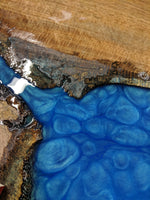Exotherm, Pot Life and Gel Time
By Roderick Kabel
Exotherm, Pot Life, Gel Time, oh, my! What are these things and why they matter to your epoxy pouring can be complicated. Let’s take a look at them and see if we can make some sense out of this mumbo-jumbo.
The chemical cross-linking between mixed epoxy resin and hardener molecules as it cures will generate heat. This heat is called the exothermic reaction and when this heat cannot escape, it builds up, causing the mixed epoxy to cure faster. Epoxy cures faster at higher temperatures.
Epoxy curing faster because of heat produces even more heat, even faster. This runaway train is why possibly a gallon of epoxy mixed all at once could turn solid in 5 minutes, maybe quicker. The resulting massive buildup of heat could cause the curing epoxy to crack because the top and bottom of the epoxy have different temperatures.
The chemical bond between epoxy resin and hardener is the mechanism that causes heat buildup. When epoxy is mixed and contained in a thick mass, it takes longer to cure. When epoxy is applied as a thin film, the thin film does not build heat due to low mass. This means the temperature through the thickness of the epoxy thin film is close to the ambient temperature.
Sometimes, pouring a large mass of epoxy all at once, blended in a mass large enough, could reach temperatures up to 400°F. This is hot enough to at least soften or even melt plastic. Likewise, such a heat level could even damage the vessel the epoxy is poured into. Severe cracking throughout the thickness of cured epoxy could also happen. And if the epoxy isn’t supported properly, it could fall away. Epoxy shrinkage due to heat is another factor that can add substantial stresses to the structure the epoxy is attached to.
Controlling exothermic reaction is next to impossible but there are ways to manage it. First, estimate how much mixed epoxy you will use for your project in a certain amount of time. Don’t mix too much if you don’t need to. Variables that affect your epoxy quantity calculation include temperature, hardener speed, volume, fillers used, surface area, and the insulating property of the substrate the epoxy is exposed to.
“Uncontrolled exotherm’ this uncontrolled heat build-up of mixed epoxy. Epoxy heating out of control can smoke, foam, and give off dangerous vapors. It can even produce enough heat to melt the container or cause nearby items to catch fire. It’s crucial to understand epoxy’s exothermic curing reaction and follow the instructions in this article very closely if you are planning to fill a large area with thick casting of epoxy.
Pot Life vs. Get Time
When mixing larger batches of resin and hardener the amount of time that elapses before the epoxy starts to thicken/harden in the container, is very important. As the exothermic reaction starts to build, the “Pot Life” of the epoxy quickly shortens. Pot Life is the time you have after mixing epoxy to the relative time you have to pour the epoxy; to the time the epoxy becomes incapable of performing/providing a desired outcome. An increase of 10°F above the average 77°F will usually shorten the pot-life by 5 minutes.
The term “Pot Life” is often used interchangeably with the term “Gel Time,” although there are differences. Both terms are used to describe the thickening of an epoxy (viscosity) after it is mixed. Pot Life is defined as the amount of time it takes for an initial mixed viscosity to double, or quadruple. Gel Time (more of a technical lab term) is measured and tested at elevated temperatures and is determined by heating the epoxy and observing when it starts to become stringy, or gel-like, though not quite fully cured.
If you are using a larger amount of resin, simply use a smaller size mixing cup, mix multiple, smaller batches as you go, the length of Pot Life will vary. Likewise, working in a cooler environment will help to increase the Pot Life and not allow the exothermic reaction to get out of control. Cooler shop temperatures and cooling the poured epoxy itself (use a fan) will slow the cure and help control the epoxy’s heat buildup (exothermic reaction).


Leave a comment